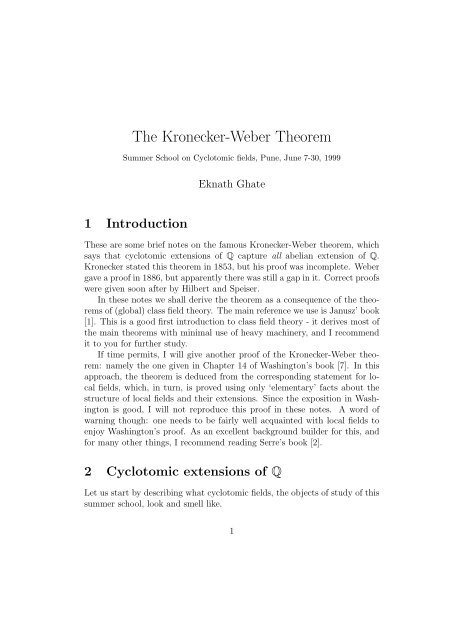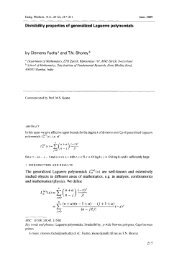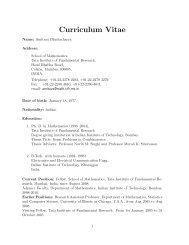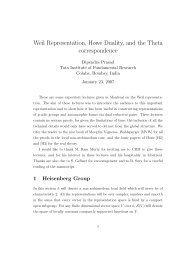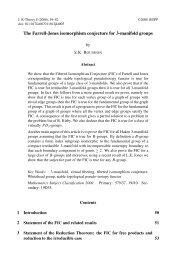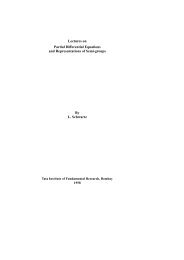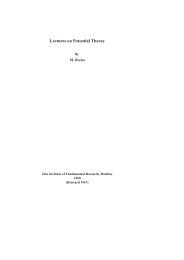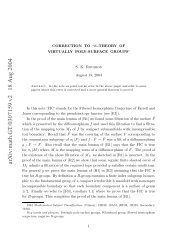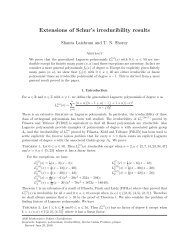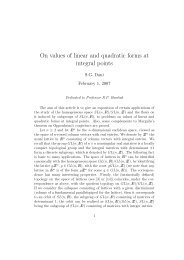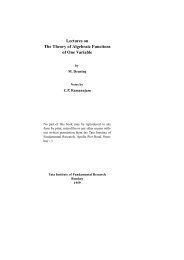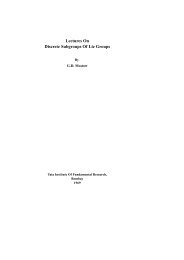The Kronecker-Weber Theorem
The Kronecker-Weber Theorem
The Kronecker-Weber Theorem
You also want an ePaper? Increase the reach of your titles
YUMPU automatically turns print PDFs into web optimized ePapers that Google loves.
<strong>The</strong>orem 7 (Artin Reciprocity <strong>The</strong>orem) Let L/K be a finite abelianextension. <strong>The</strong>n there exists a modulus m divisible by at least the primes ofK which ramify in L such that the kernel of the Artin map is given by:ker φ L/K = N L/K (I m L) · K m,1 . (2)Let us say that the modulus m divides m ′ (and write m|m ′ ) if each placethat occurs in m occurs in m ′ with equal or larger exponent. It is a fact thatif (2) holds for m then it holds for all moduli m ′ which are divisible by m. Sothe following definition is rather natural:Definition 3 <strong>The</strong> greatest common divisor of all the moduli m such that (2)holds is called the conductor of L/K.Note: It is not clear that, so defined, the conductor of L/K is divisible byall the ramified primes, but this is in fact true.3.3 An exampleIt is about time that we gave an example to illustrate the above concepts.What better place to start than with cyclotomic fields? So let us set K = Q,and L = Q(ζ n ), for some fixed n.We will show that the Artin reciprocity theorem (<strong>The</strong>orem 7) holds forQ(ζ n )/Q with the modulus m = n · ∞, where ∞ is the unique real infiniteplace of Q. We must include ∞ in the modulus since ∞ ramifies in thetotally imaginary field Q(ζ n ).Let p be a prime not dividing n. <strong>The</strong>n the ideal (p) is unramified inL. Moreover, σ p (see <strong>The</strong>orem 1 for notation) satisfies the condition (1)characterizing the Frobenius at p, so we see that φ Q(ζn)/Q(p) = σ p . Thisshows that for any two positive integers a and b relatively prime to n,φ Q(ζn)/Q(a/b) = σ ab ∗, (3)where b ∗ is a positive integer prime to n with bb ∗ ≡ 1(mod n). This formulaallows us to compute the kernel of the Artin map. Indeed, we may easilycompute thatker φ Q(ζn)/Q = {(a/b) | a, b positive, a ≡ b (mod n)} = Q m,1 . (4)7
3.5 Existence theoremThough we have now ‘proved’ the <strong>Kronecker</strong>-<strong>Weber</strong> theorem, let us pick upsome loose ends and round off our whirlwind survey of class field theory.We return to the general situation: L/K will denote an abelian extension ofnumber fields.Note that if K ≠ Q, then so far, no part of the discussion above guaranteesthe existence of even one abelian extension L of K! This is remedied by thefollowing:<strong>The</strong>orem 8 (Existence <strong>The</strong>orem) Let m be a modulus. <strong>The</strong>n there existsa finite abelian extension L/K, such that every prime of K that ramifies inL occurs in m f , and such that (2) above holds.This modulus m may not be the conductor of the extension L/K, but bydefinition, the conductor certainly divides it. Also, curiously, some modulimay never be conductors at all (example: m = ∞ is never the conductor ofany finite abelian extension of Q). However, once a modulus m occurs as aconductor, it is a fact that there is a maximal finite abelian extension, L m ,having m as its conductor. It turns out that in this case ker φ Lm/K = K m,1 .Definition 4 L m is called the ray class field of conductor m.Note that via the Artin map, the Galois group of the ray class field ofconductor m is just the ray class group modulo m. Also note that everyabelian extension L of K sits inside a ray class field, namely the one whoseconductor is the conductor of L. Finally, in the case when K = Q (seeSection 3.3), we see that the cyclotomic fields are the ray class fields (ofconductor m = n · ∞).3.6 Classification theoremWe now wish to state the climactic theorem of class field theory - the Classificationtheorem - which says roughly that the abelian extensions L of K areparameterized by gadgets constructed purely out of K! Let us make somepreliminary definitions:Definition 5 A group H is said to be a congruence subgroup of level m ifit satisfiesK m,1 ⊂ H ⊂ I m K ,9
for some modulus m.<strong>The</strong> key example of a congruence subgroup of course is the following: ifL/K is a finite abelian extension of K, then the Artin reciprocity theoremsays that H = ker φ L/K , is a congruence subgroup of level m for some modulusm.To rid us of the somewhat unpleasant dependence on the modulus m, wenow put an equivalence relation ∼ on the set of congruence subgroups.But first let us make a remark. Let m and m ′ be two moduli, with m ′ |m.<strong>The</strong>n IK m is a subgroup of Im′ K . If H′ is a congruence subgroup of level m ′then there may or may not be a congruence subgroup H of level m such thatH = IK m ∩H′ . If this does happen then we say that the congruence subgroupH is the restriction of the congruence subgroup H ′ .Now say (H 1 , m 1 ) and (H 2 , m 2 ) are two congruence ∣ subgroups. We setH 1 ∼ H 2 , if there exists a modulus m, with m i m, for i = 1, 2, and so thatIK m ∩ H 1 = IK m ∩ H 2 as restricted congruence subgroups of level m.Definition 6 An ideal group [H] is an equivalence class of congruence subgroups(H, m) with respect to the equivalence relation ∼.<strong>The</strong> ideal groups are the ‘gadgets’ referred to above which parameterizeabelian extensions of K. In fact we have:<strong>The</strong>orem 9 (Classification <strong>The</strong>orem) <strong>The</strong> mapL/K ↦→ [ker φ L/K ]is an inclusion reversing bijection between the set of abelian extensions L ofK and the set of ideal groups of K.Here ‘inclusion reversing’ means that if the abelian extensions L 1 and L 2correspond to the ideal groups [H 1 ] and [H 2 ] respectively, thenL 1 ⊂ L 2 ⇐⇒ [H 2 ] ⊂ [H 1 ].(Note: [H 2 ] ⊂ [H 1 ] simply means that there are congruence subgroups H ∈[H 2 ] and H ′ ∈ [H 1 ] of the same level such that H ⊂ H ′ ; one needs to checkthat this is well defined).10
3.7 Hilbert class field<strong>The</strong>re is one particular ray class field that is the simplest and most important.This is the Hilbert class field. It is defined to be the ray class fieldof conductor m = 1. We shall denote it by U. <strong>The</strong> following theorem nowfollows easily, after the discussion above.<strong>The</strong>orem 10 <strong>The</strong> Hilbert class field U is the maximal finite everywhere unramifiedabelian extension of K. Moreover, the Artin map establishes anisomorphism between the class group of K and Gal(U/K). In particular theclass number of K is just [U : K].As a consequence of this theorem we see that a prime p of K splitscompletely in U if and only if it is a principal ideal of K. This is not to beconfused with the following theorem, which was proved by Furtwangler.<strong>The</strong>orem 11 (Principal Ideal <strong>The</strong>orem) Every ideal of K becomes principalin U.Obviously, the Hilbert class field of Q is just Q itself, since Q has classnumber 1. But the above theorems show that the Hilbert class field for anumber field with non-trivial class number is a very interesting object. Weshall say a little more about the Hilbert class field of an imaginary quadraticsituation in the next section.3.8 Complex multiplicationWe have seen that the ray class field of Q of conductor m = n · ∞ is exactlythe cyclotomic field Q(ζ n ), and that every abelian extension of Q sits in oneof these ray class fields. This is indeed a very satisfying result since we cangenerate explicitly all the abelian extension of Q by values of the exponentialfunction e 2πiz at certain division points z ∈ Q/Z.A central problem in class field theory is to be able to similarly generatethe abelian extensions of an arbitrary number field by values of transcendentalfunctions. In fact this problem has its origins in <strong>Kronecker</strong>’s famous‘Jugendtraum’ (= youthful dream, in German).When K is an imaginary quadratic field, this problem has been completelysolved by the so called theory of ‘complex multiplication’. Essentially the ideais that the ray class fields are generated by values of the famous j function at11
points in the imaginary quadratic field K, as well as by values of the <strong>Weber</strong>function w, at division points of an elliptic curve with complex multiplicationby K. It would take us too far afield from the purpose of these notes to makethis any more precise. However, to get our toes wet, let us at least describehow to generate the Hilbert class field of K.For each z ∈ C with positive imaginary part, let j(z) be the correspondingvalue of the elliptic modular function, defined bywhereg 2 (z) = 60j(z) = 1728 ·g 2 (z) 3g 2 (z) 3 − 27g 3 (z) 2,∑ 1(mz + n) 4, g ∑ 13(z) = 140(mz + n) 6.(0,0)≠(m,n)∈Z 2 (0,0)̸=(m,n)∈Z 2<strong>The</strong>n we have the beautiful theorem:<strong>The</strong>orem 12 Let Let K be an imaginary quadratic field, with ring of integersO K = Z + Zτ. <strong>The</strong>n j(τ) is an algebraic integer, and U = K(j(τ)) is theHilbert class field of K.3.9 Hilbert’s twelfth problem<strong>The</strong> generation of ray class fields by the values of transcendental functionswas emphasized by Hilbert in his ‘twelfth problem’ presented at the ParisInternational Congress of Mathematicians in 1900. He wrote“<strong>The</strong> extension of <strong>Kronecker</strong>’s theorem to the case that in place ofthe realm of rational numbers or of the imaginary quadratic fieldany algebraic field whatever is laid down as realm of rationality,seems to me of the greatest importance. I regard this problemas one of the most profound and far reaching in the theory ofnumbers and of functions.”So far very little progress has been made on the problem in general. However,in closing these notes, let us at least mention some additional specialcases that have been partially treated:12
3.9.1 CM fieldsFrom the point of view of ‘complex multiplication’ the most natural way toto generalize the results obtained for imaginary quadratic fields is to replaceelliptic curves by higher dimensional abelian varieties. This was done byShimura and Taniyama, who managed to generate class fields of ‘CM fields’.A CM field is the higher analog of an imaginary quadratic field: it is a totallyimaginary quadratic extensions of a totally real field. It must be pointed outthat unfortunately not all abelian extension of CM fields can be generatedby this method.Shimura and Taniyama’s theory is exposed in their book [5]. <strong>The</strong>re isalso a new edition, [4], now on the market. 1See also Wafa Wei’s (unpublished) thesis, where she gives some informationabout the maximal abelian extension of a CM field that can be generatedby the values of automorphic functions [8].3.9.2 Real quadratic fieldsSome partial results have been obtained by Shimura in this case using abelianvarieties with real multiplication. For more details see the last chapter of hisbook [3].3.9.3 Stark’s methodAnother approach to Hilbert’s twelfth problem has been proposed by Stark,who has shown that certain abelian extensions of arbitrary number fields canbe generated by the values of Artin L-functions at s = 0. You could look atTate’s efficient monograph [6] for more details.References[1] G. Janusz. Algebraic number fields. Academic Press, New York-London,1973.1 In the preface to [5] it was claimed that Hecke had shown how to generate classfields of certain CM bi-quadratic extensions of Q by values of Hilbert modular functions.Apparently this work of Hecke was not complete (see the preface to [4]), but in any case,has since been corrected and subsumed by the work [4].13
[2] J.-P. Serre. Local fields, GTM 67. Springer-Verlag, Berlin-New York,1979.[3] G. Shimura. Introduction to the arithmetic theory of automorphic functions.Princeton Univ. Press, Princeton, 1971.[4] G. Shimura. Abelian varieties with complex multiplication and modularfunctions, Princeton Mathematical Series, 46. Princeton Univ. Press,Princeton, 1999.[5] G. Shimura and Y. Taniyama. Complex multiplication of abelian varietiesand its applications to number theory, Publications of the MathematicalSociety of Japan, 6. <strong>The</strong> Mathematical Society of Japan, Tokyo, 1961.[6] J. Tate. Les conjectures de Stark sur les fonctions L d’Artin en s = 0.Birkhäuser, 1984.[7] L. Washington. Introduction to cyclotomic fields, Second edition.Springer-Verlag, Berlin-New York, 1996.[8] W. Wei. Moduli fields of CM-motives applied to Hilbert’s 12th problem.Preprint, Available on the world wide web at http://www.mathematik.unibielefeld.de/sfb343/preprints/pr94070.ps.gz,1994.14


